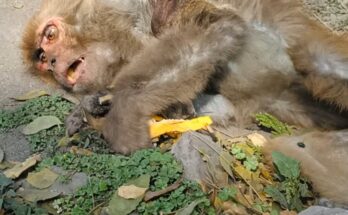In the quiet stillness of the African bush, a deadly drama unfolds beneath the shade of an acacia tree. A massive rock python, Africa’s largest snake, coils its muscular body around a young impala that wandered too close. The impala, wide-eyed and struggling, kicks desperately, but it’s already trapped in a vice-like embrace from which there is no escape.
The ambush was swift and silent. Rock pythons are not venomous—they rely entirely on stealth, speed, and raw strength. With lightning reflexes, the python struck from the underbrush, seizing the impala by the neck before quickly wrapping its coils around the animal’s body. Now, each time the impala exhales, the python tightens its grip, preventing the lungs from fully expanding. It’s a slow, suffocating death—a methodical and efficient way of hunting.
The impala’s breathing becomes shallow, its struggles weakening. The once graceful creature, known for its agility and speed, lies helpless under the crushing weight of its attacker. Within minutes, the fight ends. Silence returns to the bush, broken only by the rustle of dry grass as the python adjusts its grip.
The python begins the next phase of its hunt—swallowing its prey whole. Starting from the head, it works the limp body slowly into its gaping jaws, stretching impossibly wide. This process can take hours, but the python is in no rush. Once consumed, the impala will fuel the snake for weeks, perhaps even months.
This haunting scene is a reminder of nature’s cold but necessary balance. The python, patient and powerful, plays its role in the wild food chain with quiet precision. Though brutal to witness, this act of predation is part of the cycle that keeps the ecosystem in motion—harsh, raw, and undeniably real.


